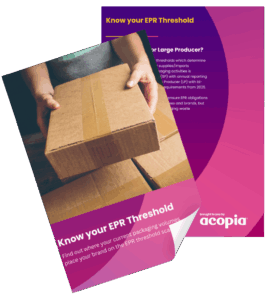It seems with every passing year, there is a new green tax, initiative or regulation to adhere to. With many seeing 2025 as the year of unsustainable costs (National Insurance and the new workplace recycling scheme adding more financial pressure), how are organisations preparing for these sustainability taxes? Navigating which ones apply and how to mitigate liability is now suddenly a resource issue in itself.
DEFRA, the Environment Agency and HMRC are spearheading their individual sustainability schemes which can at times appear to be at odds with each other while trying to achieve similar packaging reduction objectives. While interconnected, each serve different purposes in the overall waste management strategy.
Whether you’re a retailer, manufacturer or supply chain manager, understanding the key differences between EPR, PRNs, and PPT is vital to staying compliant, competitive, and environmentally responsible.
So let’s take a look at how these taxes are designed to improve packaging design, reduce plastic waste and lead to a more circular economy. Read on to understand more about how Extended Producer Responsibility (EPR), Packaging Recovery Notes (PRN’s) and the Plastic Packaging Tax (PPT) applies to brand owners, packaging producers and users.
Extended Producer Responsibility (EPR)
What it is:
EPR shifts the responsibility for the environmental impact of packaging from local authorities to the producers. This is a fundamental change in how packaging waste is collected and managed in the UK meaning that the packaging producers and retail brand owners will pay the cost for household waste collections, recycling, and disposal of all packaging waste.
Key features:
- Obligated producers are companies handling more than 50 tonnes of packaging annually and with turnover exceeding £2 million
- Requires detailed reporting on materials used and its recyclability
- Costs are based on the type of packaging used and ease of recycling
- Encourages producers to design packaging more sustainably
Why it matters:
It’s no longer just about recycling – it’s about making smarter packaging design choices upfront. EPR penalises packaging that’s hard to recycle and rewards recyclable materials, making sure that packaging sustainability is now considered before anything else in the packaging design process.

Packaging Recovery Notes (PRNs)
What they are:
PRNs are certificates that prove the amount of packaging waste has been recovered or recycled. Under the current system, obligated companies must purchase PRN’s to offset the packaging they produce and place on the market.
Key features:
- A market-based system – PRN prices fluctuate based on supply and demand
- Operates under the Producer Responsibility Obligations (Packaging Waste) Regulations
- Still relevant during the EPR transition period
- PRNs support recycling infrastructure
Why it matters:
PRNs have been the cornerstone of packaging compliance for years. While EPR will change the landscape, PRNs will continue to play a role in funding recycling through evidence-based compliance.
Plastic Packaging Tax (PPT)
What it is:
Introduced in April 2022, the Plastic Packaging Tax applies to plastic packaging manufactured in or imported into the UK that contains less than 30% recycled plastic.This applies whether it is PCR (post consumer recycled waste) or PIR (post industrial recycled waste) pallet wrap. It was designed to stimulate the need for recycled content by creating a cost incentive for using less virgin plastic. The long term ambition is to encourage investment in plastic recycling infrastructure.
Key features:
- £223.69 per tonne as of April 2025, which has risen annually
- Currently aimed at packaging with less than 30% recycled plastic content
- Businesses still need to keep detailed records, even if they don’t pay the tax.
- Encourages the use of more recycled content in packaging
Why it matters:
PPT is a financial lever to increase demand for recycled plastic. It affects pricing, procurement and packaging development. Compliance is mandatory, whether you’re a brand owner or distributor.
Key differences for EPR, PRN’s and PPT in a nutshell
EPR covers all packaging materials and entire lifecycle costs
PRNs focus specifically on recycling evidence
Plastic Packaging Tax specifically targets virgin plastic content

EPR, PRN’s and the Plastic Packaging Tax Comparison Table
Packaging levies are here to stay
The regulatory landscape is only going to get tougher as we try to tackle the impact packaging waste is having on our environment which could look like:
- Further integration of EPR and PRN systems
- Potential increases in the Plastic Packaging Tax rate
- Expansion of EPR to other product categories
- Enhanced focus on reuse systems alongside recycling
A large number of businesses will need to comply with all three of these Regulations which can lead to compliance complexities such as understanding the different reporting requirements, thresholds and timelines needed to manage each effectively. Then there is navigating the potentially conflicting definitions and scopes between the schemes.
For example, HMRC’s Plastic Packaging Tax is purely focussed on the proportion of recycled plastic content being used and is not concerned with end of life waste management and therefore might not have an impact on wider plastic pollution issues. Whilst EPR is not concerned with the packaging material itself – but more on how easy it is to dispose of when used.
However, collectively the schemes target different aspects of sustainability and holistically drives demand for recycled content and better end of life recyclability.
Achieving and maintaining compliance
No doubt your business is well on its way with data collection and reporting, but there are always ways to extend your knowledge and reduce your overall liabilities:
- Audit your packaging. Understand more about the recyclability, recycled content, and materials you’re using.
- Collaborate with suppliers. Packaging decisions made upstream will have downstream cost consequences.
- Explore material alternatives. Redesign with recyclability and recycled content in mind.
Staying ahead of these regulations isn’t just about avoiding fines — it’s about futureproofing your brand, improving your sustainability credentials, and protecting your bottom line.
When approached strategically, these systems can drive meaningful progress toward a more circular packaging economy—reducing virgin material use while ensuring packaging is effectively collected, sorted, and recycled at end-of-life.
Need help navigating EPR, PRNs or PPT? Let’s chat – we make compliance clear, not complicated.
